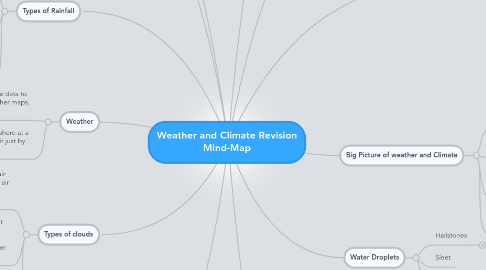
1. Weather
1.1. meteorologic or weather scientists use data to write weather reports, and draw weather maps, and make weather forecast.
1.2. DEF- Weather is the state of atmosphere at a given time. You can tell a lot about it just by looking.
2. Equipment for measuring the Weather
2.1. Thermometer
2.2. Anemometer ( wind turns the cups which turns a counter).
2.3. Barometer
2.4. Wind Vane
2.5. Rain Gauge
2.6. Visibility Meter ( a beam of light is sent out and a sensor measures how much arrives).
3. Types of clouds
3.1. Cumulus Clouds- They are usually the result of warm air rising fast. for example when the ground heats up the air quickly on a hot day, or air rises at the side of a mountain.
3.2. Stratus Clouds- They are the result of air rising more slowly, over the wide area. For example when a warm air mass slides up slowly over a cold on, leading to frontal rain.
3.3. Cirrus Clouds- They are usually the sign that warm front is arriving.
4. Types of Rainfall
4.1. CONVECTIONAL RAINFALL- The air rises because the ground heats it up. it rises as currents of warm air. We call these Convection Currents. So we call the rain Convectional Rainfall.
4.2. RELIEF RAINFALL- Wind is moving the air. When the wind meets a line of high hills or mountains there's only a way to go up! We call this Relief Rainfall.
4.3. FRONTAL RAINFALL- As you can imagine, huge blocks of air call air masses move around the earth. When a warm air mass meets a cold one, the warm air is forced to rise.So we get rain. This is called Frontal Rainfall.
5. Air Pressure-
5.1. New node
5.1.1. Although we can't feel it all the air above is pressing down on us, giving air pressure. If air pressure if LOW,it means that the air is rising. If it is high it means that the air is sinking. And each brings a different weather
6. Earth Tilt
6.1. The earth travels non stop around the sun. It is tilted as it travels. And that's why the climate in different places can be so different, in different months. The tilt gives our planet seasons.
7. Big Picture of weather and Climate
7.1. Weather is the state of the atmosphere around us. (Warm,Wet, Windy). It can change from hour to hour.
7.2. The main causes of weather are the sun, and water vapor.
7.3. Climate is the average weather in a place- what is usually like there
7.4. Climate changes from place to place, because of the factors such as distance from the equator, and from sea
8. Two main causes that create weather
8.1. The sun
8.1.1. the sun heats the Earth. but it does not heat it evenly, because the earth is round. So the top and the bottom don't warm up much. The Earth in turn heats the air- so the air also warms unevenly. Warmer air rises. Colder air then moves in to take it's place, as Wind.
8.2. Water vapor
8.2.1. The sun also warms the oceans. This causes water to evaporate to give a gas, Water Vapor- the second main cause of weather. the Water Vapor mixes through the air, helped by wind.So there is some in the air around you even if you are miles away from water. The water Vapor also rises up to the sky and creates clouds. Which then cause rain.
9. Water Droplets
9.1. Hailstones
9.1.1. New node
9.1.1.1. New node
9.1.2. New node
